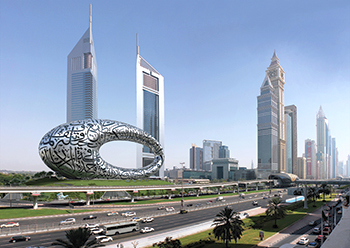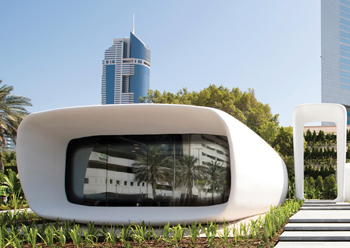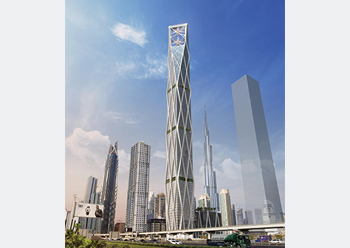
Museum of the Future ... the calligraphy on the museum’s façade provides glazed openings to the interior spaces.
Facades soar to heights of sophistication
The facades sector is entering a new dimension, with a high level of sophistication that enables the construction of complex structures that are aesthetic, functional, well-engineered and environment-responsive, BENJAMIN PIPER of Killa Design tells Gulf Construction.
01 October 2019
The facades sector is witnessing interesting times with new sophisticated systems and innovative performance enhancements of older technology, creating a myriad of options to give flight to the architect’s imagination, according to Benjamin Piper, partner and design principal at architectural design firm Killa Design.
Speaking to Gulf Construction ahead of the Future of Facades Summit held in conjunction with the Windows, Doors and Facades (WDF) exhibition last month (September 24) where he was a key speaker, Piper says the sophistication behind off-the-shelf systems-based facades is great for architects because it offers a wider choice of systems with beautiful proportions, quality finishes, and well-engineered mechanisms.
“There are quite a number of interesting developments on what would appear to be conventional-looking facades,” he says.
 |
|
Office of the Future ... design led by Piper of Killa Design. |
This has been made possible through advancements in material science, which have greatly enhanced the performance of standard glazing. For example, specialised coatings allow glass to remain relatively clear but prevent the transmission of infrared energy and, in effect, improve the shading coefficient of the glass. This is good news for architects who are searching for the clearest possible glass, the largest openings, and the highest-quality colour rendition through the glass, while meeting the requirements of the authorities and the budget, Piper says.
Also, it is now possible to fabricate increasingly complex architectural forms. Three-dimensional digital models can be shared directly with the fabricator. “This means there’s no need to translate the project into two-dimensional drawings: we can replicate the digital model in the physical world using automated fabrication processes,” he says.
The outcome is an incredible drop in the cost of complexity through CAD/CAM (computer-aided design and computer-aided manufacturing) processes. Facades that previously would have been too costly to consider are now becoming feasible within the budgets of a typical project, according to Piper.
“As the fabrication cost of complex and non-standard facades decreases, it is now possible to incorporate unique forms or environment-responsive forms, such as creating varying densities of shading patterns on glass in relation to the varying solar exposure on different elevations of the building,” he says.
 |
|
SRG Tower ... the facade design and the structural design are integrated. |
Another important development in the facades sector is the variety of shading systems available, such as those incorporated into double-glazed units to adjust the shading of the façade.
He says: “There are two fundamentally different types of dynamic, responsive facades. The first type is the ‘mechanical system’ that uses moving parts, such as louvres or external blinds, to help improve the energy performance of the façade. The second type is the ‘solid-state system’, which uses material technology to respond to the exposure of a façade, embedding, for example, liquid crystals or other materials that change the performance characteristics of the glass.”
Among the latter are electrochromic glazing and embedded liquid crystal devices (LCD). Electrochromic glazing increases or decreases the opacity of the glass depending on an electric charge that is applied to the glass interlayer.
“These devices, which have been conventionally used in interior applications to provide shade from the sun’s rays, are increasingly being utilised as part of the external facade of buildings. It makes sense to incorporate shading elements in the façade itself because it minimises the impact from the sun’s energy,” Piper points out.
An example of embedded LCD is Sage Glass, which uses liquid crystals within the glass interlayer to dynamically respond to solar conditions, thus enhancing the sustainability of a project. This proven technology for external glazing systems has been used at the Swiss School in Dubai, he says.
Another interesting emerging technology is the use of algae within a double-glazed unit.
“This type of algae-based façade system uses a biological response within the double-glazed unit; as the sun’s intensity increases, the algae grow and absorb the sun’s energy, reducing the transmittance through the glass into the internal space. This research project goes to show how one can harness some of the natural phenomena in terms of bio-responsiveness to allow facades to respond in a dynamic way to different conditions,” he explains.
Another innovation, most commonly used in roof areas, is an ETFE air-inflated bladder which is covered on the inside and outside face with an inverse checkerboard pattern. When inflated, sunlight can pass through the air-bladder owing to the separation of the patterns. When air is removed from the bladder, the inverse checkerboard pattern combines in one plane to create an opaque surface that prevents sunlight from entering the space.
So how responsive has the region been to these technologies?
Piper comments: “By and large, the region is very much driven by cost. But one must consider both the capital cost and the operational cost of a building. Increasingly, both developers and end-users are understanding the value of investing more upfront in order to have buildings that are less costly to operate over the long term. A good-performing façade can attract tenants and investors, and essentially pay back the investment in such facades over a relatively short period – hence we are seeing a greater focus on implementing measures to improve building performance.”
Piper is a director and design principal at Killa Design, which was founded four-and-a-half years ago. The company is working on a variety of ambitious and large-scale projects that push the envelope in terms of facade design. Among its more complicated and challenging projects is the Museum of the Future in Dubai.
“Here, we had to overcome the challenge of incorporating calligraphy at an architectural scale on the surface of a double-curved building envelope,” he says. “The calligraphy on the museum’s façade provides glazed openings to the interior spaces. These windows are placed on the double curved surface of the torus-shaped volume of the stainless-steel clad structure.”
Killa Design relishes these types of learning challenges, because “it allows us to push the envelope in terms of design and fabrication technology; it keeps each project unique and fresh, allowing us to develop new ideas, new approaches, and new ways of looking at facades,” Piper remarks.
His firm is currently working on the 475-m SRG residential tower in Dubai, where the facade design and the structural design are integrated. The structure itself projects outside the building envelope – in effect, becoming an exoskeleton that contributes to the overall performance of the building.
“Essentially, we have integrated the facade and the structure; by projecting the structure outside of the envelope, it has the effect of reducing the impact of the wind on the building and offers a significant degree of self-shading since the structure itself projects beyond the line of the glass. This provides a significant reduction in solar exposure while adding to the overall aesthetic of the building, giving it a unique identity,” he explains.
Piper has 20 years of professional experience in architecture, 13 of them being in the UAE. He has held senior roles in a variety of global practices including Gensler, Halcrow, Atkins, Perkins+Will and Killa Design in designing hospitality, residential and mixed-use developments in the Middle East, India, China, the US and the UK. Projects that are now completed or under construction, and designed by Piper, include the Vida Marina branded residences and hotel (56 floors), BLVD Heights residential tower (45 floors); Creekside Residence (52 floors), 300-key Acacia Residences, and the BLVD Address five-star hotel and serviced apartment (62 floors) – all for Emaar in Dubai.
Elsewhere, he has led the design of the Office of the Future (the first fully-occupied 3D printed building) in Dubai; the 35-storey commercial office building for Barwa Bank headquarters, Qatar; 280-key Diplomatic Quarter hotel serviced residences for Marriott, Riyadh; and the 60-storey Namaste hotel for Starwood, Mumbai, and 10,000-seat occupancy IT offices for ITC, Bangalore, both in India.
- Facades soar to heights of sophistication
- Reynaers secures key ‘green’ certifications
- Bruag panels add aesthetic appeal


